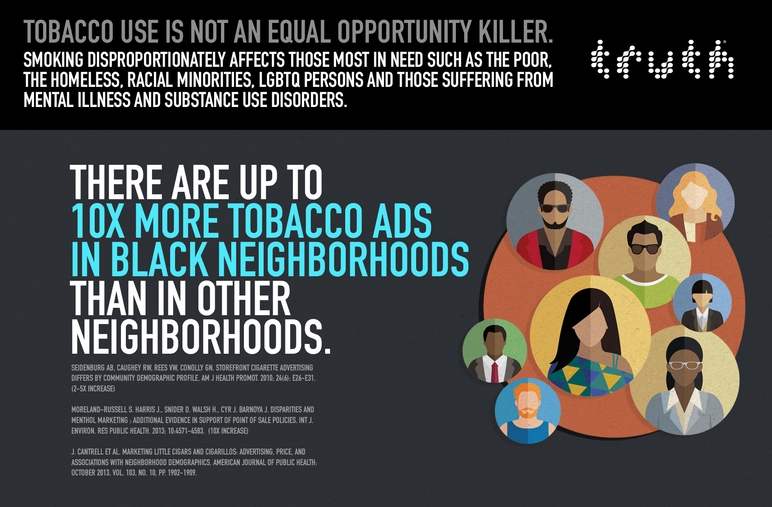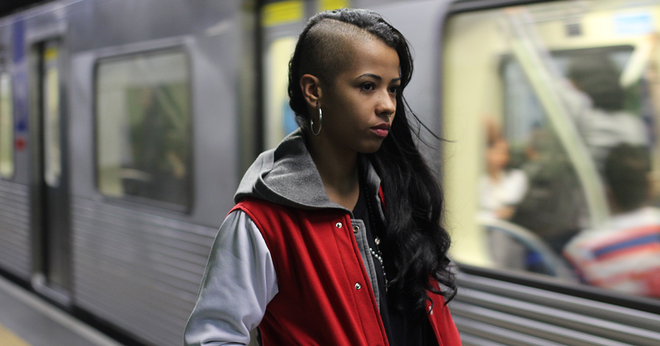Tobacco is a social justice issue: Racial and ethnic minorities
While the youth smoking rate has now dropped to a record low of 6 percent, that number does not tell the whole story. Tobacco use disproportionately affects many marginalized populations—including people in low-income communities, racial and ethnic minorities, LGBT individuals and those with mental illness—who have a long and documented history of being targeted by the tobacco industry.
Black people smoke at a similar rate compared to white people, with 16.7 percent smoking every day or some days, but they are more likely to die from a tobacco-related disease than white people. American Indians and Alaska Natives smoke at higher rates than all other racial and ethnic groups, with 21.9 percent reporting that they have smoked every day or some days.
Why do these disparities along lines of race and ethnicity exist? The answer is tied to the many ways that tobacco use disproportionately affects minority groups, who have a long history of being targeted by the tobacco industry.

Capitalizing on culture
Tobacco companies have strategically marketed tobacco products to appeal to racial and ethnic communities for decades.
The most striking example is menthol cigarettes. These cigarettes, which are easier to smoke and harder to quit, have long been marketed to the black community. About 85 percent of all black smokers use menthol cigarettes, a rate that is nearly three times higher than white smokers. (More on menthol smoking rates.)
Big Tobacco has sponsored cultural events, targeted direct mail promotions and placed advertising in publications and venues that are popular with black audiences. For example, a 2011 review concluded that Ebony magazine was almost 10 times more likely than People magazine to contain an advertisement for menthol cigarettes. The marketing is so pervasive, that a 2013 study found that black children were three times more likely to recognize advertisements for Newport, the most popular menthol brand among that group, than other children.
Tobacco companies have also sponsored activities linked with cultural traditions. A partial list: Mexican rodeos, American Indian powwows, Chinese New Year and Cinco de Mayo festivities and events related to Black History Month, Asian/Pacific American Heritage month and Hispanic Heritage Month.
A community presence
Tobacco use also disproportionately affects many racial and ethnic minority groups because of where they live.
Research shows that more tobacco retailers exist in areas with larger black, Hispanic and low-income populations. More stores selling tobacco means more exposure to point-of-sale marketing, which Big Tobacco spent more than $8 billion on in 2014. Point-of-sale promotions—not just in-store advertising, but things like discounts and product displays behind check-out counters—have been the industry’s top marketing strategy for nearly 30 years, receiving even more investment after the 1998 Master Settlement Agreement restricted marketing tactics, such as billboard and transit ads and the use of cartoons such as Joe Camel to appeal to children.
Studies have also observed differences among stores in minority communities. For example, researchers in Washington, D.C. found that stores in predominantly black neighborhoods were up to ten times more likely to display tobacco ads inside and outside than retailers in areas with fewer black residents. Other studies have shown that predominantly black communities across the country have more advertising and cheaper prices for menthol cigarettes. In addition, Hispanic neighborhoods not only have more tobacco retailers than areas with more white residents, but also more stores selling tobacco products to underage customers.
For more information on the disproportionate effect tobacco has on racial and ethnic minorities, read the Achieving Health Equity report.
More in targeted communities
Want support quitting? Join EX Program
By clicking JOIN, you agree to the Terms, Text Message Terms and Privacy Policy.
Msg&Data rates may apply; msgs are automated.


